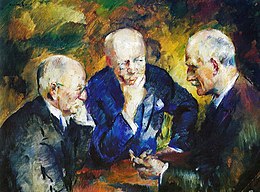Christian Sinding
Christian Sinding | |
|---|---|
 Sinding c. 1930 | |
| Born | 11 January 1856 Kongsberg, Norway |
| Died | 3 December 1941 (aged 85) Oslo, Norway |
| Occupation |
|

Christian August Sinding (11 January 1856 – 3 December 1941) was a Norwegian composer. He is best known for his lyrical work for piano Frühlingsrauschen (Rustle of Spring, 1896). He was often compared to Edvard Grieg and regarded as his successor.[1]
Personal life
[edit]Sinding was born at Kongsberg in Buskerud, Norway. His parents were mine superintendent Matthias Wilhelm Sinding and Cecilie Marie Mejdell. He was a brother of the painter Otto Sinding and the sculptor Stephan Sinding. His sister Thora Cathrine Sinding was married to jurist Glør Thorvald Mejdell.[2][3]
Christian Sinding was a nephew of Nicolai Mejdell and Thorvald Mejdell. He was also a first cousin of journalist and writer Alfred Sinding-Larsen.[2][4]
In November 1898 he married actress Augusta Gade, née Smith-Petersen (1858–1936). She was the daughter of Morten Smith-Petersen and Cathrine von der Lippe. She had previously been married to physician and art patron Fredrik Georg Gade.[2][5]
Career
[edit]He studied music first in Christiania (now Oslo) before going to Germany, where he studied at the conservatory in Leipzig under Salomon Jadassohn and fell under the musical influences of Wagner and Liszt. He lived in Germany for much of his life, but received regular grants from the Norwegian government. In 1921–22 he went to the United States of America to teach composition for a season at the Eastman School of Music in Rochester, New York.[6] [7] [8]
Sinding's publishers required from him piano and chamber music, which had broader sales than the symphonic works he preferred. His own instrument was the violin. The large number of short, lyrical piano pieces and songs that Sinding wrote has led to many seeing him as the heir to his fellow countryman, Edvard Grieg, not so much in musical style but as a Norwegian composer with an international reputation. Sinding is best remembered today for one of his piano works, Frühlingsrauschen (Rustle of Spring, 1896). Among his other works are four symphonies,[9] three violin concertos, a piano concerto,[10] chamber music, songs and choral works to Norwegian texts, and an opera, Der Heilige Berg (The Holy Mountain, 1914).[11]
Awards
[edit]Sinding was made a member of the Order of St. Olav in 1905 and Commander in 1916, and in 1938, received the Grand Cross. He was appointed a Commander of the Order of Vasa and in 1905, he was made a member of the Royal Swedish Academy of Music.[1] In 1924 he was granted the honor of lifetime residence at Henrik Wergeland's former home, Grotten in Oslo.[12]
Legacy
[edit]Sinding had suffered from severe senile dementia since the late 1930s. Eight weeks before his death in 1941, Sinding joined the Norwegian Nazi party, Nasjonal Samling - however, his membership card was unsigned. The Nazis had strong motivation to recruit Sinding, as he was tremendously popular before the war in both Norway and Germany. Following the liberation of Norway at the end of World War II, it was official practice for the national broadcasting system to boycott people seen as Nazi sympathisers. As a consequence, Sinding's post-war reputation in Norway became relatively obscure. The circumstances surrounding the composer's membership continue to raise controversy. Sinding had made several remarks against the Nazi occupation. He had fought for the rights of Jewish musicians during the early 1930s and was a close friend of Nordahl Grieg.[13][14]
Compositions
[edit]Documents
[edit]Letters by Christian Sinding held by the State Archives in Leipzig, company archives of the Music Publishing House C.F.Peters (Leipzig).
References
[edit]- ^ a b Rune J. Andersen. "Christian Sinding". Store norske leksikon. Retrieved April 1, 2018.
- ^ a b c Vollestad, Per. "Christian Sinding". In Helle, Knut (ed.). Norsk biografisk leksikon (in Norwegian). Oslo: Kunnskapsforlaget. Retrieved 9 June 2010.
- ^ Ebbell, Chr. (1940). "Mejdell, Glør Thorvald". In Brøgger, A. W.; Jansen, Einar (eds.). Norsk biografisk leksikon (in Norwegian). Vol. 9 (1st ed.). Oslo: Aschehoug. pp. 137–140.
- ^ Ljøgodt, Knut. "Otto Sinding". In Helle, Knut (ed.). Norsk biografisk leksikon (in Norwegian). Oslo: Kunnskapsforlaget. Retrieved 9 June 2010.
- ^ Per Holck. "Fredrik Gade". Norsk biografisk leksikon. Retrieved April 1, 2018.
- ^ "JEAN SIBELIUS NOT COMING.; Sinding, Norwegian Composer, to Replace Him In Eastman School". The New York Times. 1921-05-25. Retrieved 2020-12-03.
- ^ Georg Predota (May 18, 2016). "Christian August Sinding, The Forgotten Norwegian Composer". interlude. Retrieved April 1, 2018.
- ^ "Christian Sinding". Den Store Danske. Retrieved April 1, 2018.
- ^ Symphony No. 1 in D minor, op. 21 (1890, revised 1895); the more Wagnerian Symphony No. 2 in D major Op. 83 (1904); Symphony no.3 in F major op.121 (1919); the Rhapsody for Orchestra “Vinter og Vår” (1936) in seven movements, which had occupied him at times since 1921, is sometimes counted as a fourth symphony.
- ^ Piano Concerto in D flat major, op. 6 (1890, revised 1901), dedicated to Norwegian pianist Erika Nissen.
- ^ "Christian Sinding". arkivmusic.com. Archived from the original on April 13, 2018. Retrieved April 1, 2018.
- ^ "Grotten". Kunsthistorie. Retrieved April 1, 2018.
- ^ "Per Vollestad". Archived from the original on 2006-08-20. Retrieved 2006-11-18. (In Norwegian)
- ^ Alfred Fidjestøl. Eit stille jubileum Archived 2007-08-16 at the Wayback Machine (Klassekampen. January 2, 2006)
External links
[edit]- 1856 births
- 1941 deaths
- 19th-century Norwegian classical composers
- 19th-century Norwegian male musicians
- 20th-century Norwegian classical composers
- 20th-century Norwegian male musicians
- Commanders of the Order of Vasa
- Male opera composers
- Members of Nasjonal Samling
- Norwegian male classical composers
- Norwegian opera composers
- Norwegian Romantic composers
- Musicians from Kongsberg
- Pupils of Salomon Jadassohn
- Recipients of the St. Olav's Medal
- University of Music and Theatre Leipzig alumni
